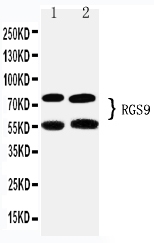Anti-RGS9 Antibody
- SPECIFICATION
- CITATIONS
- PROTOCOLS
- BACKGROUND

Application
| WB |
|---|---|
| Primary Accession | O75916 |
| Host | Rabbit |
| Reactivity | Human, Mouse, Rat |
| Clonality | Polyclonal |
| Format | Lyophilized |
| Description | Rabbit IgG polyclonal antibody for Regulator of G-protein signaling 9(RGS9) detection. Tested with WB in Human;Mouse;Rat. |
| Reconstitution | Add 0.2ml of distilled water will yield a concentration of 500ug/ml. |
| Gene ID | 8787 |
|---|---|
| Other Names | Regulator of G-protein signaling 9, RGS9, RGS9 |
| Calculated MW | 76966 MW KDa |
| Application Details | Western blot, 0.1-0.5 µg/ml, Human, Mouse, Rat |
| Subcellular Localization | Isoform 3: Membrane; Peripheral membrane protein. Isoform 3 is targeted to the membrane via its interaction with RGS9BP. . |
| Tissue Specificity | Highly expressed in the caudate and putamen, lower levels found in the hypothalamus and nucleus accumbens and very low levels in cerebellum. Not expressed in globus pallidus or cingulate cortex. Isoform 2 is expressed predominantly in pineal gland and retina. Isoform 3 is expressed in retina (abundant in photoreceptors). |
| Protein Name | Regulator of G-protein signaling 9 |
| Contents | Each vial contains 5mg BSA, 0.9mg NaCl, 0.2mg Na2HPO4, 0.05mg Thimerosal, 0.05mg NaN3. |
| Immunogen | A synthetic peptide corresponding to a sequence at the C-terminus of human RGS9(624-638aa LKSKRVANFFQIKMD), different from the related mouse and rat sequences by three amino acids. |
| Purification | Immunogen affinity purified. |
| Cross Reactivity | No cross reactivity with other proteins |
| Storage | At -20˚C for one year. After r˚Constitution, at 4˚C for one month. It˚Can also be aliquotted and stored frozen at -20˚C for a longer time.Avoid repeated freezing and thawing. |
| Sequence Similarities | Contains 1 DEP domain. |
| Name | RGS9 |
|---|---|
| Function | Inhibits signal transduction by increasing the GTPase activity of G protein alpha subunits thereby driving them into their inactive GDP-bound form. Binds to GNAT1. Involved in phototransduction; key element in the recovery phase of visual transduction (By similarity). |
| Cellular Location | [Isoform 3]: Membrane; Peripheral membrane protein. Note=Isoform 3 is targeted to the membrane via its interaction with RGS9BP. |
| Tissue Location | Highly expressed in the caudate and putamen, lower levels found in the hypothalamus and nucleus accumbens and very low levels in cerebellum. Not expressed in globus pallidus or cingulate cortex. Isoform 2 is expressed predominantly in pineal gland and retina. Isoform 3 is expressed in retina (abundant in photoreceptors) |

Thousands of laboratories across the world have published research that depended on the performance of antibodies from Abcepta to advance their research. Check out links to articles that cite our products in major peer-reviewed journals, organized by research category.
info@abcepta.com, and receive a free "I Love Antibodies" mug.
Provided below are standard protocols that you may find useful for product applications.
Background
Regulator of G-protein signaling 9, also known as RGS9 is a human gene, which codes for a protein involved in regulation of signal transduction inside cells. This gene is mapped to 17q24.1. This gene encodes a member of the RGS family of GTPase activating proteins that function in various signaling pathways by accelerating the deactivation of G proteins. This protein is anchored to photoreceptor membranes in retinal cells and deactivates G proteins in the rod and cone phototransduction cascades. Mutations in this gene result in bradyopsia. Multiple transcript variants encoding different isoforms have been found for this gene.
If you have used an Abcepta product and would like to share how it has performed, please click on the "Submit Review" button and provide the requested information. Our staff will examine and post your review and contact you if needed.
If you have any additional inquiries please email technical services at tech@abcepta.com.













 Foundational characteristics of cancer include proliferation, angiogenesis, migration, evasion of apoptosis, and cellular immortality. Find key markers for these cellular processes and antibodies to detect them.
Foundational characteristics of cancer include proliferation, angiogenesis, migration, evasion of apoptosis, and cellular immortality. Find key markers for these cellular processes and antibodies to detect them. The SUMOplot™ Analysis Program predicts and scores sumoylation sites in your protein. SUMOylation is a post-translational modification involved in various cellular processes, such as nuclear-cytosolic transport, transcriptional regulation, apoptosis, protein stability, response to stress, and progression through the cell cycle.
The SUMOplot™ Analysis Program predicts and scores sumoylation sites in your protein. SUMOylation is a post-translational modification involved in various cellular processes, such as nuclear-cytosolic transport, transcriptional regulation, apoptosis, protein stability, response to stress, and progression through the cell cycle. The Autophagy Receptor Motif Plotter predicts and scores autophagy receptor binding sites in your protein. Identifying proteins connected to this pathway is critical to understanding the role of autophagy in physiological as well as pathological processes such as development, differentiation, neurodegenerative diseases, stress, infection, and cancer.
The Autophagy Receptor Motif Plotter predicts and scores autophagy receptor binding sites in your protein. Identifying proteins connected to this pathway is critical to understanding the role of autophagy in physiological as well as pathological processes such as development, differentiation, neurodegenerative diseases, stress, infection, and cancer.


